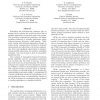Free Online Productivity Tools
i2Speak
i2Symbol
i2OCR
iTex2Img
iWeb2Print
iWeb2Shot
i2Type
iPdf2Split
iPdf2Merge
i2Bopomofo
i2Arabic
i2Style
i2Image
i2PDF
iLatex2Rtf
Sci2ools
104
click to vote
ISCAPDCS
2004
2004
A VFSA Scheduler for Radiative Transfer Data in Climate Models
Scheduling and load-balancing techniques play an integral role in reducing the overall execution time of scientific applications on clustered multi-node systems. The increasing computational complexity and higher modeling resolutions of scientific applications makes balanced resource allocation a high priority. While many existing load-balancing approaches attempt to reduce cluster communication overhead by statically estimating job task allocation to the system configuration, there exist significant opportunities to integrate domain-specific information into adaptive scheduling strategies. One such domain is that of atmospheric geophysical data. The evolution of Atmospheric General Circulation Models (AGCMs) and the atmospheric geophysical data on which they rely deem it necessary to revisit prior work in the area of load-balancing. We present a technique that employs Very Fast Simulated Annealing (VFSA) to reduce the load-imbalances associated with radiative-transfer processes found...
Atmospheric Geophysical Data | ISCAPDCS 2004 | ISCAPDCS 2007 | Load-balancing Techniques | Scientific Applications |
| Added | 31 Oct 2010 |
| Updated | 31 Oct 2010 |
| Type | Conference |
| Year | 2004 |
| Where | ISCAPDCS |
| Authors | S. P. Muszala, Gita Alaghband, Daniel A. Connors, James J. Hack |
Comments (0)

